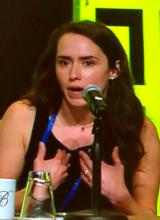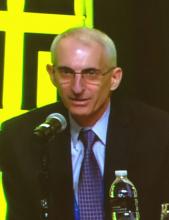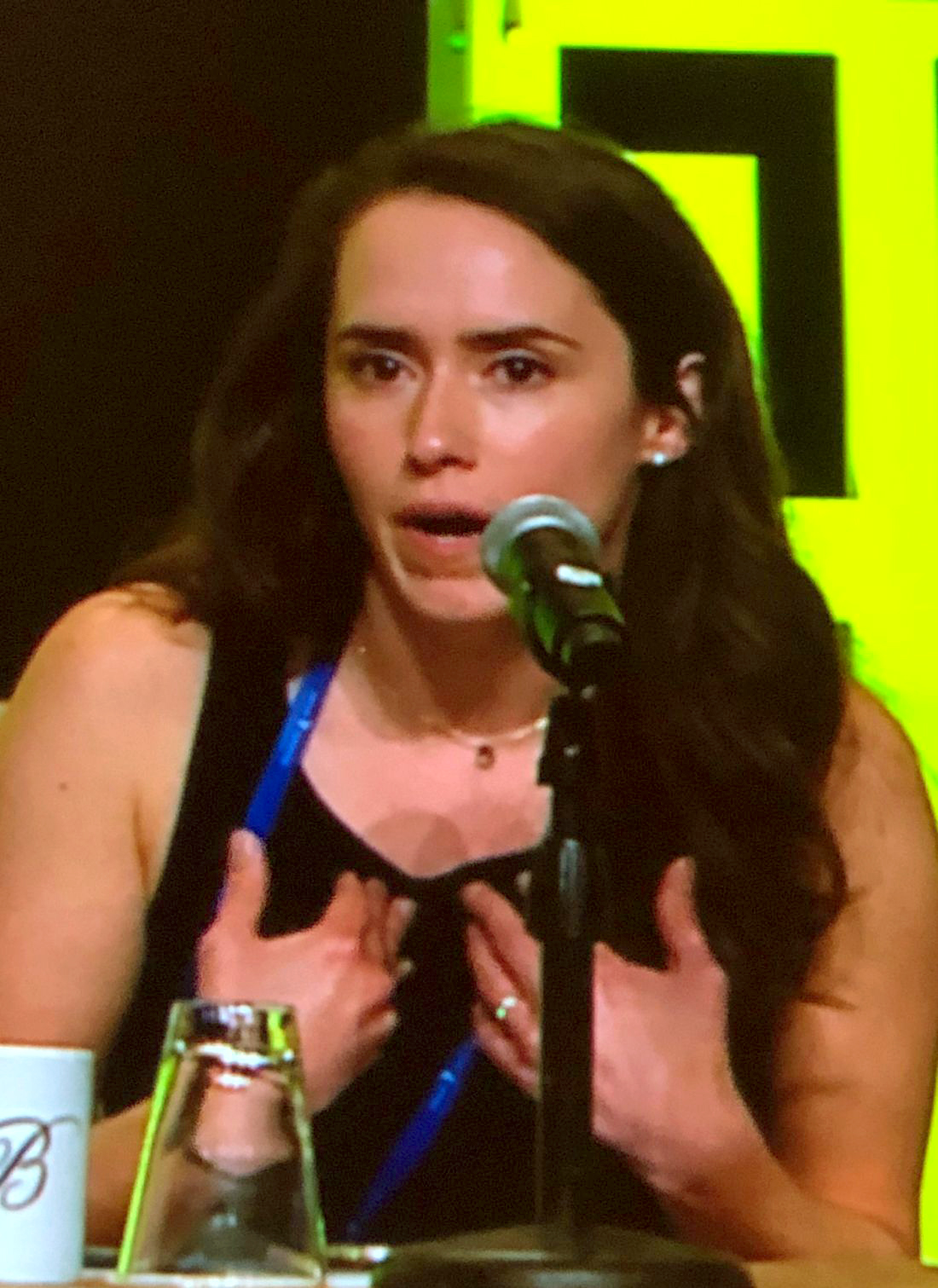User login
LAS VEGAS – Temporarily switching to an enteral diet – without solid food – has the potential to reverse Crohn’s disease (CD), especially in children, a panel of experts told gastroenterologists here.
They acknowledged the controversial treatment requires strict adherence and can be impossible for some patients to tolerate. But it can be successful too, said gastroenterologist Lindsey G. Albenberg, DO, of Children’s Hospital of Philadelphia, where enteral nutrition therapy (ENT) is commonly used in patients with CD.
“Parents are obviously thrilled that there’s no exposure to immunosuppressive medications,” she said in a discussion about ENT at the Crohn’s & Colitis Congress - a partnership of the Crohn’s & Colitis Foundation and the American Gastroenterological Association. “Typically, we provide 80%-90% of calorie needs through a polymeric formula by mouth. If we see clinical response at 4-6 weeks or even earlier, then we will pursue a course of about 8-12 weeks.”
Research into the best role for ENT therapy in CD is limited. A 2018 Cochrane Library review found there’s “very low quality evidence” suggesting that ENT is better than steroids to induce remission in children. It also found there’s “very low quality evidence” that steroids are better than ENT in adults with CD (Cochrane Database Syst Rev. 2018 Apr 1. doi: 10.1002/14651858.CD000542.pub3).
According to clinician-scientist James D. Lewis, MD, MSCE, of the University of Pennsylvania, Philadelphia, ENT “has gotten a bad name in some ways because of a meta-analysis showing it was inferior to corticosteroids to induce remission.” In fact, he said, studies “didn’t look at mucosal healing and pooled together adults and children.”
In children, he said, the treatment seems to clearly be effective. The picture is less promising in adults. “Presumably that’s because those of you who are parents probably have more control over your young children than your own behavior,” he said, referring to management of food intake.
In adults, “there’s no reason to think it wouldn’t work,” he said. “But trying to convince adults to give up food is really challenging.”
Children who try ENT are often required to use a nasogastric feeding tube, an approach that adults tend to avoid. In kids, “it’s a question of knowing your patient,” said gastroenterologist David Suskind, MD, of Seattle Children’s Hospital. “If the patient says, ‘There’s no way you’ll put a nasal gastric tube in, and no way I will drink it [the ENT supplement],’ this may not be the best therapy. If they’re interested, we push forward. We get much better efficacy because the patients will do what we’re asking.”
Several panelists recommended that patients use polymeric formulations instead of elemental formulations because they’re more palatable. It can be a struggle, however, to stick with the treatment.
Kelly Issokson, MS, RD, CNSC, a dietitian with Cedars-Sinai Medical Center in Los Angeles, tried an ENT therapy for 30 days in order to understand what patients experience and said it was “very challenging.”
“When you sit down to a meal, you anticipate it, you start to salivate. With shakes, it was a lot more clinical,” she said. “The other thing I struggled with was texture and having it be so sweet. I’d freeze [the shakes] into ice cube trays and popsicles. That helped break the monotony. It changes the flavor and cuts the sweetness.”
Ms. Issokson urges her patients to stick with ENT for the entire period of therapy. “Studies show when patients introduce real foods the efficacy of inducing remission goes down. We recommend 100% calories and proteins coming from the formula,” she said. That means “no coffee, no broth, no tea, no nothing but the formula. Most of our patients are able to do that exclusively.”
Toward the end of therapy, around week 8 or 11, some patients tell her they crave food like soup. “I say OK, have a tiny bit,” she said, “but remember, this is only temporary. We’re almost at the end. Try to be 100% exclusive.”
Dr. Albenberg and Dr. Suskind report no disclosures. Ms. Issokson reports consulting fees (speaking and teaching) from AGA, Crohn’s & Colitis Foundation, Academy of Nutrition and Dietetics, and United Ostomy Association. Dr. Lewis reports many relationships – including consulting fees, ownership interest, and grant/research support – with Eli Lilly, Bristol‐Myers Squibb, Gilead, and others.
Correction, 2/22/19: An earlier version of this article misidentified the person in the first photo above.
LAS VEGAS – Temporarily switching to an enteral diet – without solid food – has the potential to reverse Crohn’s disease (CD), especially in children, a panel of experts told gastroenterologists here.
They acknowledged the controversial treatment requires strict adherence and can be impossible for some patients to tolerate. But it can be successful too, said gastroenterologist Lindsey G. Albenberg, DO, of Children’s Hospital of Philadelphia, where enteral nutrition therapy (ENT) is commonly used in patients with CD.
“Parents are obviously thrilled that there’s no exposure to immunosuppressive medications,” she said in a discussion about ENT at the Crohn’s & Colitis Congress - a partnership of the Crohn’s & Colitis Foundation and the American Gastroenterological Association. “Typically, we provide 80%-90% of calorie needs through a polymeric formula by mouth. If we see clinical response at 4-6 weeks or even earlier, then we will pursue a course of about 8-12 weeks.”
Research into the best role for ENT therapy in CD is limited. A 2018 Cochrane Library review found there’s “very low quality evidence” suggesting that ENT is better than steroids to induce remission in children. It also found there’s “very low quality evidence” that steroids are better than ENT in adults with CD (Cochrane Database Syst Rev. 2018 Apr 1. doi: 10.1002/14651858.CD000542.pub3).
According to clinician-scientist James D. Lewis, MD, MSCE, of the University of Pennsylvania, Philadelphia, ENT “has gotten a bad name in some ways because of a meta-analysis showing it was inferior to corticosteroids to induce remission.” In fact, he said, studies “didn’t look at mucosal healing and pooled together adults and children.”
In children, he said, the treatment seems to clearly be effective. The picture is less promising in adults. “Presumably that’s because those of you who are parents probably have more control over your young children than your own behavior,” he said, referring to management of food intake.
In adults, “there’s no reason to think it wouldn’t work,” he said. “But trying to convince adults to give up food is really challenging.”
Children who try ENT are often required to use a nasogastric feeding tube, an approach that adults tend to avoid. In kids, “it’s a question of knowing your patient,” said gastroenterologist David Suskind, MD, of Seattle Children’s Hospital. “If the patient says, ‘There’s no way you’ll put a nasal gastric tube in, and no way I will drink it [the ENT supplement],’ this may not be the best therapy. If they’re interested, we push forward. We get much better efficacy because the patients will do what we’re asking.”
Several panelists recommended that patients use polymeric formulations instead of elemental formulations because they’re more palatable. It can be a struggle, however, to stick with the treatment.
Kelly Issokson, MS, RD, CNSC, a dietitian with Cedars-Sinai Medical Center in Los Angeles, tried an ENT therapy for 30 days in order to understand what patients experience and said it was “very challenging.”
“When you sit down to a meal, you anticipate it, you start to salivate. With shakes, it was a lot more clinical,” she said. “The other thing I struggled with was texture and having it be so sweet. I’d freeze [the shakes] into ice cube trays and popsicles. That helped break the monotony. It changes the flavor and cuts the sweetness.”
Ms. Issokson urges her patients to stick with ENT for the entire period of therapy. “Studies show when patients introduce real foods the efficacy of inducing remission goes down. We recommend 100% calories and proteins coming from the formula,” she said. That means “no coffee, no broth, no tea, no nothing but the formula. Most of our patients are able to do that exclusively.”
Toward the end of therapy, around week 8 or 11, some patients tell her they crave food like soup. “I say OK, have a tiny bit,” she said, “but remember, this is only temporary. We’re almost at the end. Try to be 100% exclusive.”
Dr. Albenberg and Dr. Suskind report no disclosures. Ms. Issokson reports consulting fees (speaking and teaching) from AGA, Crohn’s & Colitis Foundation, Academy of Nutrition and Dietetics, and United Ostomy Association. Dr. Lewis reports many relationships – including consulting fees, ownership interest, and grant/research support – with Eli Lilly, Bristol‐Myers Squibb, Gilead, and others.
Correction, 2/22/19: An earlier version of this article misidentified the person in the first photo above.
LAS VEGAS – Temporarily switching to an enteral diet – without solid food – has the potential to reverse Crohn’s disease (CD), especially in children, a panel of experts told gastroenterologists here.
They acknowledged the controversial treatment requires strict adherence and can be impossible for some patients to tolerate. But it can be successful too, said gastroenterologist Lindsey G. Albenberg, DO, of Children’s Hospital of Philadelphia, where enteral nutrition therapy (ENT) is commonly used in patients with CD.
“Parents are obviously thrilled that there’s no exposure to immunosuppressive medications,” she said in a discussion about ENT at the Crohn’s & Colitis Congress - a partnership of the Crohn’s & Colitis Foundation and the American Gastroenterological Association. “Typically, we provide 80%-90% of calorie needs through a polymeric formula by mouth. If we see clinical response at 4-6 weeks or even earlier, then we will pursue a course of about 8-12 weeks.”
Research into the best role for ENT therapy in CD is limited. A 2018 Cochrane Library review found there’s “very low quality evidence” suggesting that ENT is better than steroids to induce remission in children. It also found there’s “very low quality evidence” that steroids are better than ENT in adults with CD (Cochrane Database Syst Rev. 2018 Apr 1. doi: 10.1002/14651858.CD000542.pub3).
According to clinician-scientist James D. Lewis, MD, MSCE, of the University of Pennsylvania, Philadelphia, ENT “has gotten a bad name in some ways because of a meta-analysis showing it was inferior to corticosteroids to induce remission.” In fact, he said, studies “didn’t look at mucosal healing and pooled together adults and children.”
In children, he said, the treatment seems to clearly be effective. The picture is less promising in adults. “Presumably that’s because those of you who are parents probably have more control over your young children than your own behavior,” he said, referring to management of food intake.
In adults, “there’s no reason to think it wouldn’t work,” he said. “But trying to convince adults to give up food is really challenging.”
Children who try ENT are often required to use a nasogastric feeding tube, an approach that adults tend to avoid. In kids, “it’s a question of knowing your patient,” said gastroenterologist David Suskind, MD, of Seattle Children’s Hospital. “If the patient says, ‘There’s no way you’ll put a nasal gastric tube in, and no way I will drink it [the ENT supplement],’ this may not be the best therapy. If they’re interested, we push forward. We get much better efficacy because the patients will do what we’re asking.”
Several panelists recommended that patients use polymeric formulations instead of elemental formulations because they’re more palatable. It can be a struggle, however, to stick with the treatment.
Kelly Issokson, MS, RD, CNSC, a dietitian with Cedars-Sinai Medical Center in Los Angeles, tried an ENT therapy for 30 days in order to understand what patients experience and said it was “very challenging.”
“When you sit down to a meal, you anticipate it, you start to salivate. With shakes, it was a lot more clinical,” she said. “The other thing I struggled with was texture and having it be so sweet. I’d freeze [the shakes] into ice cube trays and popsicles. That helped break the monotony. It changes the flavor and cuts the sweetness.”
Ms. Issokson urges her patients to stick with ENT for the entire period of therapy. “Studies show when patients introduce real foods the efficacy of inducing remission goes down. We recommend 100% calories and proteins coming from the formula,” she said. That means “no coffee, no broth, no tea, no nothing but the formula. Most of our patients are able to do that exclusively.”
Toward the end of therapy, around week 8 or 11, some patients tell her they crave food like soup. “I say OK, have a tiny bit,” she said, “but remember, this is only temporary. We’re almost at the end. Try to be 100% exclusive.”
Dr. Albenberg and Dr. Suskind report no disclosures. Ms. Issokson reports consulting fees (speaking and teaching) from AGA, Crohn’s & Colitis Foundation, Academy of Nutrition and Dietetics, and United Ostomy Association. Dr. Lewis reports many relationships – including consulting fees, ownership interest, and grant/research support – with Eli Lilly, Bristol‐Myers Squibb, Gilead, and others.
Correction, 2/22/19: An earlier version of this article misidentified the person in the first photo above.
EXPERT ANALYSIS FROM THE CROHN’S & COLITIS CONGRESS


